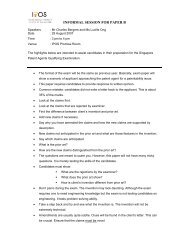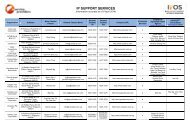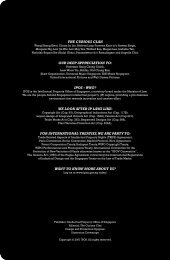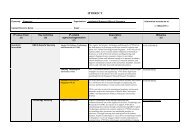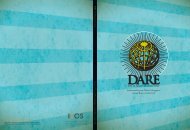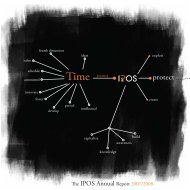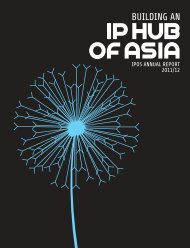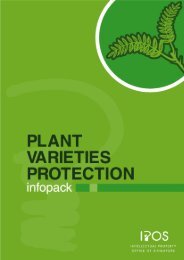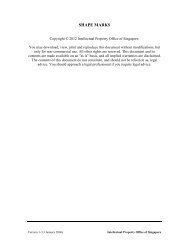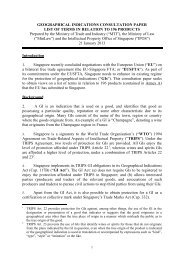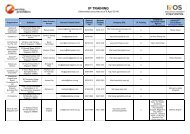Letter & Annex A - Intellectual Property Office of Singapore
Letter & Annex A - Intellectual Property Office of Singapore
Letter & Annex A - Intellectual Property Office of Singapore
Create successful ePaper yourself
Turn your PDF publications into a flip-book with our unique Google optimized e-Paper software.
<strong>Intellectual</strong> <strong>Property</strong> <strong>Office</strong> <strong>of</strong> <strong>Singapore</strong>51 Bras Basah Road #04-01Plaza By The Park <strong>Singapore</strong> 189554Tel: (65) 63398616 Fax: (65) 63390252http://www.ipos.gov.sg3 July 2009Dear Sir/Mdm,CONSULTATION PAPER ON THE PROPOSED CHANGES TO THE PATENTSYSTEM 2009InvitationYou are invited to submit written comments on the proposed changes to the PatentsSystem which are set out in the enclosed consultation document and summarised in <strong>Annex</strong> A.Information for persons making submissions to this Paper2. Please submit your comments/suggestions in the template in <strong>Annex</strong> B and email it toIPOS at IPOS_iplawfeedback@ipos.gov.sg when completed. It is recommended that thesubmission be saved in the MS Word format for easy collation.3. The closing date for submission is 14 August 2009.4. In submitting your feedback, you agree that unless your representations are clearlymarked “Confidential”, IPOS may disclose and make available the representations to the generalpublic, in whole or in part, through its website or other means.5. Thank you.INTELLECTUAL PROPERTY OFFICE OF SINGAPOREPlaza By The Park51 Bras Basah Road, 04-01<strong>Singapore</strong> 189554Encl. <strong>Annex</strong> A: Proposed Changes to the Patent System 2009<strong>Annex</strong> B: Feedback Template
<strong>Intellectual</strong> <strong>Property</strong> <strong>Office</strong> <strong>of</strong> <strong>Singapore</strong>51 Bras Basah Road #04-01Plaza By The Park <strong>Singapore</strong> 189554Tel: (65) 63398616 Fax: (65) 63390252http://www.ipos.gov.sg[BLANK PAGE]
<strong>Annex</strong> AProposed Changes to the Patent System 2009INTELLECTUAL PROPERTY OFFICE OF SINGAPOREJULY 2009
<strong>Annex</strong> AProposed Changes to the Patent System 2009ContentsGlossary <strong>of</strong> Terms Used1 Introduction2 Proposed Changes to the Patent Self-Assessment (PSA) Regime2.1 The Self-assessment Regime2.2 Proposed PSA Changes - Local and Mixed RouteInvitation 12.3 Proposed PSA Changes: Foreign Route - Prescribed Information and IPRPInvitation 2Invitation 32.4 Proposed PSA Changes: Post-grant AmendmentsInvitation 42.5 Proposed PSA Changes: Post-grant Search and ExaminationInvitation 53 Other Proposed Changes: Patent Application ProcessInvitation 64 Other Proposed Changes: Extension <strong>of</strong> TimeInvitation 7Invitation 85 Other Proposed Changes: RestorationInvitation 9Invitation 106 Other Proposed Changes: Renewal ReminderInvitation 117 Other Proposed Changes: Second or Subsequent New Medical Use ClaimsInvitation 12Page 1 <strong>of</strong> 31
<strong>Annex</strong> AGlossary <strong>of</strong> Terms UsedTermMeaningClaims correspondencetableDeadlineInternational preliminaryreport on patentability(IPRP)Mixed examinationreport/results/IPRPNegative examinationreport/results/IPRPPositive examinationreport/results/IPRPPrescribed informationA table referencing the claim numbers <strong>of</strong> two sets <strong>of</strong> claimswith an explanation how the two sets <strong>of</strong> claims are related.(see Related claims)A deadline is the last day for the prescribed requirements to besatisfied and an applicant can take action to satisfy saidrequirements earlier to expedite the application prosecution.An international preliminary report on patentability (Chapter I<strong>of</strong> the Patent Co-operation Treaty) or an internationalpreliminary report on patentability (Chapter II <strong>of</strong> the PatentCo-operation Treaty).(Section 2 <strong>of</strong> the <strong>Singapore</strong> Patents Act)At least one examined claim or a part <strong>of</strong> an examined claim isobjected to by the examiner.All examined claims are objected to by the examiner.There is no outstanding objection from the examiner.Information that indicates the result <strong>of</strong> the correspondingapplication or corresponding international application and anysymbol <strong>of</strong> the International Patent Classification allocated tothe application.(Rule 44 <strong>of</strong> the <strong>Singapore</strong> Patents Rules)Related claims A claim is related to another claim if –(i) the 2 claims are identical; or(ii) each limitation in the second claims –(A) is identical to a limitation in the first claim; or(B) differs from a limitation in the first claim only inexpression but not in content; andmore than one claim may be related to a single claim.(Section 2(4) <strong>of</strong> the <strong>Singapore</strong> Patents Act)Page 2 <strong>of</strong> 31
<strong>Annex</strong> A1 Introduction1.1 The <strong>Singapore</strong> (SG) Patents Act and Patents Rules came into force in 1995. Prior tothat, it was a simple system <strong>of</strong> re-registration <strong>of</strong> patents granted in the UnitedKingdom. Since its establishment, the Patents legislation has undergone a series <strong>of</strong>changes and enhancements in alignment with <strong>Singapore</strong>’s economic development andtrends in patent protection.1.2 As part <strong>of</strong> our on-going review, IPOS is reviewing several aspects <strong>of</strong> the patentsystem, specifically on changes to the self-assessment regime, changes to theapplication process, and changes to processes relating to extension <strong>of</strong> time,restoration, renewal reminder, and second or subsequent new medical use claims. Thisconsultation paper seeks feedback on these proposed changes and issues related to theproposed changes.1.3 Feedback received will be studied for suitable changes to be implemented.Page 3 <strong>of</strong> 31
<strong>Annex</strong> A2 Proposed Changes to the Patent Self-Assessment (PSA) Regime2.1 The Self-assessment Regime2.1.1 <strong>Singapore</strong>’s patent system is unique in terms <strong>of</strong> the patent application processes.While the criteria for what amounts to a patentable invention under the Patents Act issimilar to other patent systems, several search and examination routes are available toapplicants to choose from. These options allow flexibility as applicants decide ontheir patent prosecution strategy.2.1.2 A key feature <strong>of</strong> the existing patent system is its self-assessment nature in that apatent grant will not be refused on the ground that the invention is assessed to be notpatentable. Some patent <strong>of</strong>fices share similar features <strong>of</strong> self-assessment, for example,Switzerland and the Netherlands. Prior to grant, the applicant bears the responsibilityand onus <strong>of</strong> ensuring that his claims for patent protection meet the criteria <strong>of</strong>patentability, and take the necessary steps to amend the application, where necessary,to meet any objections raised by the examiner. The search and examination reports areopen for public inspection and scrutiny by interested parties. Challenges to thepatentability <strong>of</strong> the invention are provided for after the patent is granted. Figure 1 isan overview <strong>of</strong> the current patent system.Figure 1: An overview <strong>of</strong> the current patent system.ApplicantLocal RouteForeign Route (CA/PCT)Mixed Route (CA/PCT)NationalPCTNational PCT National PCTLocal S&E,Local S, ELocal S&ECorrespondingS&E reportsCorresponding S&E reports,IPRP(I) or IPRP(II)Corresponding S report, Local E+ve mixed -ve+ve mixed -ve +ve mixed -veExamination ReportRequest for GrantGrantS: SearchE: ExaminationCA: corresponding applicationsPage 4 <strong>of</strong> 31
<strong>Annex</strong> A2.1.3 The nature <strong>of</strong> self-assessment allows the applicant to decide whether to proceed togrant, a decision normally vested with the patent <strong>of</strong>fice in other patent systems.2.1.4 According to the grant statistics for year 2008, a high percentage <strong>of</strong> grants wereissued based on positive examination reports. Only a minority <strong>of</strong> 13% were grantedwith mixed/negative examination reports. This is evidence that a self-assessmentregime has fared reasonably well for <strong>Singapore</strong> in that applicants have exercised goodjudgment to only request for grant with positive examination reports even when thesystem allows otherwise. They are cognizant <strong>of</strong> the fact that a weak patent willhamper their enforcement actions and devalue their inventions. Nevertheless, therehave been occasions when IPOS received requests from both IP owners and thirdparties to consider moving away from the self-assessment regime.2.1.5 The patent system supports <strong>Singapore</strong>’s national economic policies by awardingmonopoly rights in exchange for the disclosure <strong>of</strong> the inventions. In light <strong>of</strong><strong>Singapore</strong>’s push to be an innovation, research and development hub in varioustechnological fields, notwithstanding that the minority <strong>of</strong> patents are granted based ona mixed/negative report, it is timely, to consider amending the patent system to grantpatents only when the examination report is positive.2.1.6 This will create a more robust system wherein only inventions meeting the <strong>of</strong>ficialassessment <strong>of</strong> patentability proceed to grant. The main considerations <strong>of</strong> the revieware:• a positive examination grant system provides greater certainty from the businessand enforcement perspective for both the patentee and third parties, and• a positive examination grant system can potentially increase the quality andstandards <strong>of</strong> <strong>Singapore</strong> granted patents.2.1.7 To adopt a positive examination grant system will necessitate a change in the searchand examination processes (the local route, the mixed route and the foreign route) sothat only applications with positive outcomes can proceed to grant. The proposedchanges are outlined below.2.2 Proposed PSA Changes: Local & Mixed Routes2.2.1 Current: Under the local route, an applicant files an application directly with IPOSand files a request for a search and examination report. The search & examinationwork is conducted by one <strong>of</strong> IPOS’ outsourced examiners. Among the <strong>Singapore</strong>patent applications which proceeded to grant in 2008, 26% utilised this route.2.2.2 Under the mixed route, an applicant files an application with IPOS (or a PCTapplication entering national phase into <strong>Singapore</strong>) relying on the search results <strong>of</strong> thecorresponding application or corresponding international application or itsinternational search report, and files a request for an examination report. Theexamination is conducted by one <strong>of</strong> IPOS’ outsourced examiners. Among the<strong>Singapore</strong> patent applications which proceeded to grant in 2008, 25% utilised thisroute.Page 5 <strong>of</strong> 31
<strong>Annex</strong> A2.2.3 Figure 2 shows the current search & examination processes and the set <strong>of</strong> timelinesfor local/mixed route applications (national or PCT applications).Figure 2: Current search & examination processes and timelines for local/mixed routeapplicationsAction Deadline Applicant IPOS CommentsApplication 0 monthSearchFast trackSlow track13 monthsNot availableSearch &Examination/ExaminationFast trackSlow trackGrant18 monthsFast trackSlow track21 months39 months39 months57 monthsRequest for anexamination reportReply to WOwithin 5 monthsReply to furtherWO within 5monthsIssue <strong>of</strong>ficeaction (WO/ ER)Examiner hasdiscretion toissue furtherWOsIssue ERSearch is notapplicable to PCTnational phaseentry applications.Informal dialoguewith examiner isavailable.Extension <strong>of</strong> time isnot allowed forreply.Informal dialoguewith examiner isavailable.Extension <strong>of</strong> time isnot allowed forreply.With positive,mixed or negativeERFast trackSlow track42 months60 monthsPay grant feeWO: written opinionER: examination reportFor PCT applications, the local examination in <strong>Singapore</strong> will take into consideration amendments madeunder Article 19/ Article 34 <strong>of</strong> the Patent Co-operation Treaty (subject to the meeting <strong>of</strong> the requirementsin section 86 <strong>of</strong> the Patents Act).2.2.4 Proposed: For applications with positive examination reports, the impact is minimal.The search and examination process for such applications will largely remain statusquo.2.2.5 Hearing: Where the examination report is mixed/negative, an additional avenue isproposed for the applicant to overcome objections by the examiner. This comes as aform <strong>of</strong> a hearing process in the event that objections cannot be overcome in thenormal course <strong>of</strong> examination. Currently informal dialogue facilities are available forapplicants to seek clarifications from the examiners on the objections raised in thewritten opinion and/or to discuss how objections can be overcome. This is done viaPage 6 <strong>of</strong> 31
<strong>Annex</strong> Aemail or telephone-conference between the examiner and the applicant, and facilitatesthe obtaining <strong>of</strong> a positive examination report.2.2.6 For an application where the examiner intends to issue a mixed/negative examinationreport, the examiner will indicate in writing an intention to issue mixed/negativereport supported with reasons, and <strong>of</strong>fer applicant an opportunity for hearing. Theapplicant may request for a hearing. If a request for a hearing is not filed within 1month, the application shall be treated as having been abandoned.2.2.7 Upon a request for a hearing, a hearing <strong>of</strong>ficer, an independent examiner from thesame examination <strong>of</strong>fice, will be appointed to hear the case. The applicant maychoose to proceed by means <strong>of</strong> written submissions, telephone-conference or videoconference and a hearing fee will be imposed. A hearing via telephone-conference orvideo-conference will be conducted with the patent applicant or his representative inIPOS and the hearing <strong>of</strong>ficer present in his <strong>of</strong>fice.2.2.8 The outcome <strong>of</strong> the hearing will be either a) examiner’s objections maintained(written grounds <strong>of</strong> refusal <strong>of</strong> application), or b) examiner’s objections overruled (apositive examination report will be issued). If the applicant is not satisfied with therefusal, he may proceed to file an appeal to the court. The applicant may also file adivisional application as long as the application is pending.2.2.9 Other related changes to the local/mixed route are:a) The deadline to establish the examination report is extended from 39 months to 41months (or 57 months to 59 months for slow track applications) to provide moreopportunities for informal dialogue/submissions to overcome the objections.b) Amendments cannot be filed prior to grant after a positive examination report isissued. This ensures that the specification for grant will be the specification asexamined.2.2.10 Figures 3(a) and 3(b) show the proposed search & examination processes andtimelines for local/mixed route applications (national and PCT applications).Page 7 <strong>of</strong> 31
<strong>Annex</strong> AFigure 3(a): Positive examination report via local/mixed routeAction Deadline Applicant IPOS CommentsApplicationSearchFast trackSlow trackSearch &Examination /ExaminationFast trackSlow trackGrant20 monthsFast trackSlow trackFast trackSlow track0 month13 monthsNot available21 months39 months41 months59 months42 months60 monthsRequest for anexaminationreportReply to WOwithin 5 monthsReply to furtherWO within 5monthsPay grant fee forpositive ERIssue <strong>of</strong>ficeaction (WO/ ER)Examiner hasdiscretion toissue furtherWOsIssue positiveERSearch is notapplicable to PCTnational phase entryapplications.Informal dialogue withexaminer available.Extension <strong>of</strong> time isnot allowed.Informal dialogue withexaminer available.Extension <strong>of</strong> time isnot allowed.If grant fee not paidapplication treated ashaving beenabandoned.WO: written opinionER: examination reportFor PCT applications, the local examination in <strong>Singapore</strong> will take into consideration amendments madeunder Article 19/ Article 34 <strong>of</strong> the Patent Co-operation Treaty (subject to the meeting <strong>of</strong> the requirementsin section 86 <strong>of</strong> the Patents Act).status quoPage 8 <strong>of</strong> 31
<strong>Annex</strong> AFigure 3b): Mixed/negative examination report via local/mixed routeAction Deadline Applicant IPOS CommentsApplicationSearchFast trackSlow track0 month13 monthsNot availableSearch is not applicableto PCT national phaseentry applications.Search &Examination /ExaminationFast trackSlow track20 monthsFast trackSlow trackHearingFast trackSlow track21 months39 months41 months59 months42 months60 monthsRequest for anexaminationreportReply to WOwithin 5 monthsReply to furtherWO within 5monthsFile request fora hearingwithin 1 monthIssue <strong>of</strong>fice action(WO/ ER)Examiner hasdiscretion to issuefurther WOsIntention to issuemixed/ negativeER. Invitation torequest for ahearing.Informal dialogue withexaminer available.Extension <strong>of</strong> time is notallowed.Informal dialogue withexaminer availableExtension <strong>of</strong> time is notallowed.If ER is mixed/negative,the grant deadline at42/60 months does notapply.If request for a hearingnot filed, applicationtreated as having beenabandoned.Issue hearingdatex months Hearing By an independentexaminery monthsIssue ER + writtendecision (ifrequired)1) positive ER2) negative/mixedERApplication is refused.Grant y+1 months 1) Pay grant fee 1) If grant fee not paid,application treated ashaving beenabandoned.2) Application isrefused. Applicant mayfile divisional applicationor appeal to the court.WO: written opinionER: examination reportFor PCT applications, the local examination in <strong>Singapore</strong> will take into consideration amendments madeunder Article 19/Article 34 <strong>of</strong> the Patent Co-operation Treaty (subject to the meeting <strong>of</strong> the requirementsin section 86 <strong>of</strong> the Patents Act).status quoPage 9 <strong>of</strong> 31
<strong>Annex</strong> AInvitation 11. What are your views about the proposed hearing process? What do you think are theimplications <strong>of</strong> the additional time to grant?2. In the current practice, do you encounter any difficulty when trying to establish aninformal dialogue with the examiner? If so, please suggest how this can be improved.3. It is proposed that there will be no opportunity to amend the specification once theexamination report is issued. This ensures the specification for grant is thespecification as examined. What are your views on this? Do you have othersuggestions?4. What are your views about the overall proposed changes to the local/mixed routes?Are they sufficient in supporting a positive grant system?It would be helpful to the Registry if such comments and feedback are accompanied bycomprehensive reasons and, where available, examples or situations in support.Page 10 <strong>of</strong> 31
<strong>Annex</strong> A2.3 Proposed PSA Changes: Foreign Route (prescribed information andInternational Preliminary Report on Patentability)2.3.1 Current: A foreign route application is an application which proceeds to grant relyingon search and examination reports conducted by a patent <strong>of</strong>fice prescribed under rule41 <strong>of</strong> the SG Patents Rules (“PPO”) or by the PCT international search orexamination authorities (“PCT authorities”). Such an application is either anapplication filed directly with IPOS with prescribed information or a PCT applicationentering national phase into <strong>Singapore</strong> relying on the international preliminary reporton patentability (Chapter I or II) (IPRP). Among the <strong>Singapore</strong> patent applicationswhich proceeded to grant in 2008, 49% utilised this route.2.3.2 Under the foreign route and relying on prescribed information, an application is fileddirectly with IPOS relying on search and examination results <strong>of</strong> a correspondingapplication or corresponding international application. With the corresponding searchand examination results, the applicant can proceed to grant. Please refer to Figure 4for the deadline to grant.2.3.3 Under the foreign route and relying on IPRP, a PCT application enters national phaseinto <strong>Singapore</strong> and the application proceeds to grant relying on the IPRP. Please referto Figure 4 for the deadline to grant.Figure 4: Deadline to grant for foreign route applicationsAction Deadline ApplicantApplication 0 monthGrantFast trackSlow track42 months60 monthsFurnish prescribed information,IPRP(I) or IPRP(II) andpay grant fee2.3.4 For foreign route (prescribed information and IPRP) applications, applicants mayamend the specification before grant. For applications relying on prescribedinformation, the claims in the <strong>Singapore</strong> application are usually amended to conformto the claims in the prescribed information. For PCT applications, amendments can bemade under Article 19 <strong>of</strong> the PCT, Article 34 <strong>of</strong> the PCT and/or during nationalphase. Applicants are to ensure the amendments are within the disclosure in theapplication as filed (section 84 <strong>of</strong> the SG Patents Act). At the point <strong>of</strong> making arequest that a certificate <strong>of</strong> grant be issued, applicants are required to declare that each<strong>of</strong> the amended claims put forth for grant is related to at least one examined claimreferred to in the prescribed information or IPRP (section 30 <strong>of</strong> the SG Patents Act).2.3.5 Proposed - Prescribed Information: Patents to be granted only to applicationsrelying on positive examination results from a PPO or the PCT authorities and theclaims put forth for grant are related to the examined claims referred to in theprescribed information.Page 11 <strong>of</strong> 31
<strong>Annex</strong> A2.3.6 If the examination results from the PPO or the PCT authorities are mixed, anapplication cannot rely on it for grant. To continue prosecuting the application in<strong>Singapore</strong>, the applicant may:• file a request for a search and examination report,• file a request for an examination report, or• delete the claim(s) in the <strong>Singapore</strong> application corresponding to the claim(s) orpart(s) <strong>of</strong> the claim(s) in the prescribed information found to be not patentable sothe <strong>Singapore</strong> application proceeds to grant only with the claims corresponding tothe claims in the prescribed information found to be patentable.Alternatively, the applicant may file a divisional application as long as the applicationis pending.2.3.7 If the examination results from the PPO or the PCT authorities are negative, anapplication cannot rely on it for grant. To continue prosecuting the application in<strong>Singapore</strong>, the applicant may:• file a request for a search and examination report, or• file a request for an examination report.Alternatively, the applicant may file a divisional application as long as the applicationis pending.2.3.8 Where the claims in the <strong>Singapore</strong> application are related to the examined claimsreferred to in the positive examination results from the PPO or the PCT authoritiesbecause they are identical (section 2(4)(a)(i) <strong>of</strong> the SG Patents Act) without the needfor amendments, the application can proceed to grant. It will not be necessary tocheck if the two sets <strong>of</strong> claims are related.2.3.9 Where the claims in the <strong>Singapore</strong> application are related to the examined claimsreferred to in the positive examination results from the PPO or the PCT authoritiesbecause they have identical limitations or have different limitations only in expressionbut not in content (section 2(4)(a)(ii) <strong>of</strong> the SG Patents Act), without the need foramendments, the applicant is required to prepare a claims correspondence tableexplaining how the two sets <strong>of</strong> claims are related. It will be necessary to check if thetwo sets <strong>of</strong> claims are related.2.3.10 Where the claims in the <strong>Singapore</strong> application are not related to the examined claimsreferred to in the positive examination results from the PPO or the PCT authorities,the applicant has to file voluntary amendments to amend the claims in the <strong>Singapore</strong>application to be related to the examined claims referred to in the prescribedinformation. The applicant is also required to prepare a claims correspondence tableexplaining how the two sets <strong>of</strong> claims are related. It will be necessary to check if thetwo sets <strong>of</strong> claims are related and if the amendments fall within the disclosure <strong>of</strong> theapplication as filed.Page 12 <strong>of</strong> 31
<strong>Annex</strong> A2.3.11 The applicant has one opportunity to file voluntary amendments to the specificationand that is at the time <strong>of</strong> furnishing the prescribed information for the purposes <strong>of</strong>complying with the related claim requirement and other requirements in the PatentsAct and/or the Patents Rules. The process in paragraph 2.3.10 will then apply.2.3.12 Below are the three possible methods to check the related claims requirement and/orthe allowability <strong>of</strong> amendments.2.3.13 Method 1: The applicant files a declaration at the time <strong>of</strong> furnishing the prescribedinformation that the two sets <strong>of</strong> claims are related and if the applicant filesamendments to the claims, he has to include in the declaration that the amendmentsfall within the disclosure <strong>of</strong> the application as filed. He also has to file a claimscorrespondence table. The amendments are allowed, the claims are deemed relatedand the application can proceed to grant.2.3.14 Please see Figure 5 for the process <strong>of</strong> Method 1.Figure 5: Method 1 - DeclarationDeclaration + a claimscorrespondence tableAmendments filed becomes a recordfor public inspectionApplication can proceedto grant2.3.15 Method 2: The applicant submits a written explanation at the time <strong>of</strong> furnishing theprescribed information that the two sets <strong>of</strong> claims are related. If the applicant filesamendments to the claims, he has to include in the written explanation that theamendments fall within the disclosure <strong>of</strong> the application as filed. He also has to file aclaims correspondence table. In addition, if the Registrar is not satisfied that therequirements are met, the Registrar may direct the applicant to file a request for aclaims allowability report with a fee. The claims in the <strong>Singapore</strong> application will beassessed by an examiner whether they are related to the examined claims referred toin the positive prescribed information (or IPRP). If there are proposed amendments,the proposed amendments will be assessed by the examiner whether they are withinthe disclosure <strong>of</strong> the application as filed.2.3.16 If the examiner approves the proposed amendments and the claims, the amendmentsare allowed, claims deemed related. A positive claims allowability report will beissued and the application can proceed to grant.2.3.17 If the examiner does not approve the proposed amendments and/or the claims, theexaminer will indicate in writing an intention to refuse the proposed amendmentssupported with reasons, and <strong>of</strong>fer applicant an opportunity for hearing. The applicantis given a deadline to request for a hearing or to take the necessary action to removeall objections stated and to put the application in order for acceptance. If the applicantdoes not take either <strong>of</strong> the actions by the expiry <strong>of</strong> the deadline, the application shallbe treated as having been abandoned.Page 13 <strong>of</strong> 31
<strong>Annex</strong> A2.3.18 Upon a request for a hearing, a hearing <strong>of</strong>ficer, an examiner from the sameexamination <strong>of</strong>fice, will be appointed to hear the case. The applicant may choose toproceed by means <strong>of</strong> written submissions, telephone-conference or video conferenceand a hearing fee will be imposed. A hearing via telephone-conference or videoconferencewill be conducted with the patent applicant or his representative in IPOSand the hearing <strong>of</strong>ficer present in his <strong>of</strong>fice.2.3.19 The outcome <strong>of</strong> the hearing will be either a) examiner’s objections maintained (anegative claims allowability report will be issued), or b) examiner’s objectionsoverruled (a positive claims allowability report will be issued). If a negative claimsallowability report is issued, the application will be refused. If a positive claimsallowability report is issued, the application can proceed to grant.2.3.20 If the applicant is not satisfied with the refusal, he may appeal to the court. Theapplicant may also file a divisional application as long as the application is pending.2.3.21 Please see Figure 6 for the process <strong>of</strong> Method 2.Figure 6: Method 2 - Written explanation and possible direction to file a request for aclaims allowability reportWritten explanation + claims correspondence tableIf Registrar is satisfied thatthe requirements are metIf Registrar is not satisfied that therequirements are met, Registrar willdirect applicant to file a request for aclaims allowability reportApplication can proceed tograntIf therequest isnot filedIf the request is filedApplicationrefusedClaimsallowableApplicationcanproceed tograntClaims notallowableIntention torefuseRequestfor ahearing isnot filedApplicationrefusedRequest for ahearing is filedApplicationcan proceedto grant2.3.22 Method 3: The application proceeds to grant based on Method 1 and Method 2becomes an option available to request for a non-binding claims allowability opinionafter grant (this is different from the claims allowability report mentioned in Method2). A fee will be imposed for this request. The non-binding claims allowabilityopinion becomes a record for public inspection. Please see Figure 7 for the process <strong>of</strong>Method 3.Figure 7: Method 3 - Declaration and optional post-grant claims allowability opinionPage 14 <strong>of</strong> 31
<strong>Annex</strong> ADeclaration + a claims correspondence tablebefore grantAmendments filed becomes a recordfor public inspectionApplication can proceed to grantOptional - Request for a claims allowability opinionafter grantClaims allowability opinionConducted by examinersA record for public inspection2.3.23 The possible paths and methods for claims allowability checks available to anapplication relying on prescribed information are summarised below.Figure 8: Summary <strong>of</strong> Proposed Foreign Route (Prescribed Information)Foreign Route – Prescribed InformationPrescribed InformationPositive S&E reportMixed S&E reportNegative S&E reportSection2(4)(a)(ii)related claimsClaims not Sectionrelated 2(4)(a)(i)related claimsDeleteobjectedclaimsApplicant toprovide claimscorrespondencetableApplicant to- amend the SG claims to be related- provide claims correspondencetableGrantProceed tolocal/ mixedrouteFile divisionalapplicationChecks required:- Amendments are within originaldisclosure, and/or- Claims are relatedMethod 1:DeclarationApplicant filesstatutory declarationto affirm that theabove requirementsare metMethod 2:Written explanation &possible direction to file arequest for a claimsallowability reportExaminers to assess thatthe above requirements aremetMethod 3:Declaration with optionalrequest for a claimsallowability opinion aftergrantApplicant files statutorydeclaration and may requestfor assessment after grant.Page 15 <strong>of</strong> 31
<strong>Annex</strong> AInvitation 21. Do you support the adoption <strong>of</strong> Method 1, 2 or 3? Given the option <strong>of</strong> your choice,will the prescribed information route still be attractive to applicants vis-à-vis otherroutes?2. For an applicant who has a mixed examination results and has to amend the claims inthe <strong>Singapore</strong> application (as opposed to a mere deletion <strong>of</strong> objected claims), how doyou suggest the application proceed in <strong>Singapore</strong> besides proceeding to request for asearch & examination report or for an examination report or file a divisionalapplication?3. For all methods, should there be an option for an applicant to request for a claimsallowability report before grant?4. What are your views about the proposed changes to the prescribed information route?It would be helpful to the Registry if such comments and feedback are accompanied bycomprehensive reasons and, where available, examples or situations in support.2.3.24 Proposed - IPRP: Similar in approach as the prescribed information route, foreignroute applications relying on IPRP will be allowed grant in <strong>Singapore</strong> only when theIPRP Chapter I or II are positive and the claims put forth for grant are related to theexamined claims referred to in the positive IPRP.2.3.25 If the IPRP is mixed, an application cannot rely on it for grant. To continueprosecuting the application in <strong>Singapore</strong>, the applicant may:• file a request for a search and examination report,• file a request for an examination report, or• delete the claim(s) in the <strong>Singapore</strong> application corresponding to the claim(s) orpart(s) <strong>of</strong> the claim(s) in the prescribed information found to be not patentable sothe <strong>Singapore</strong> application proceeds to grant only with the claims corresponding tothe claims in the prescribed information found to be patentable.Alternatively, the applicant may file a divisional application as long as the applicationis still pending.2.3.26 If the IPRP is negative, an application cannot rely on it for grant. To continueprosecuting the application in <strong>Singapore</strong>, the applicant may:• file a request for a search and examination report, or• file a request for an examination report.Alternatively, the applicant may file a divisional application as long as the applicationis still pending.2.3.27 If the IPRP (I) is positive and no amendments have been made at international ornational phase or IPRP(II) is positive and no amendments have been made at nationalphase, the application may proceed to grant. It will not be necessary to check if theclaims in the <strong>Singapore</strong> application and the claims referred to in the IPRP are related.Page 16 <strong>of</strong> 31
<strong>Annex</strong> A2.3.28 If the IPRP is positive and amendments are made under Article 19 <strong>of</strong> the Patent CooperationTreaty and/or during national phase entry, it will be necessary to check ifthe two sets <strong>of</strong> claims are related and if the amendments fall within the disclosure <strong>of</strong>the application as filed. The same three methods discussed from paragraphs 2.3.12 to2.3.22 are proposed.2.3.29 The applicant has one opportunity to file voluntary amendments to the specificationand that is at the time <strong>of</strong> filing the notice to rely on IPRP for the purposes <strong>of</strong>complying with the related claim requirement and other requirements in the PatentsAct and/or the Patents Rules. The process in paragraph 2.3.28 will then apply.2.3.30 The possible paths and claims allowability checks available to an application relyingon IPRP are summarised below.Figure 9: Summary <strong>of</strong> Proposed Foreign Route (IPRP)Foreign Route – IPRP(I), IPRP(II)IPRP (I), (II)PositiveIPRP(I)PositiveIPRP(II)MixedIPRPMixedIPRP(I)MixedIPRP(II)NegativeIPRPArt 19and/or NPNo Art 19andno NPNo NPDeleteobjectedclaimsonlyNo Art 19andno NPNo NPChecks required:• Amendments withinoriginal disclosure• Claims are relatedGrantProceed tolocal/mixedrouteFile divisionalapplicationMethod 1orMethod 2orMethod 3Art 19: Amendments made underArticle 19 <strong>of</strong> the Patent Co-operationTreatyNP: National Phase amendmentsPage 17 <strong>of</strong> 31
<strong>Annex</strong> AInvitation 31. Do you support the adoption <strong>of</strong> Method 1, 2 or 3? Given the option <strong>of</strong> your choice,will the foreign route relying on IPRP still be attractive to applicants vis-à-vis otherroutes?2. For an applicant who has a mixed IPRP and has to amend the claims in the <strong>Singapore</strong>application (as opposed to a mere deletion <strong>of</strong> objected claims), how do you suggestthe application proceed in <strong>Singapore</strong> besides proceeding to request for a search &examination report or for an examination report or file a divisional application?3. For all methods, should there be an option for an applicant to request for a claimsallowability report before grant?4. What are your views about the proposed changes to the foreign route relying on IPRProute?It would be helpful to the Registry if such comments and feedback are accompanied bycomprehensive reasons and, where available, examples or situations in support.Page 18 <strong>of</strong> 31
<strong>Annex</strong> A2.4 Proposed PSA Changes: Post-Grant Amendments2.4.1 Current: Post-grant amendments are limited to amendments which do not discloseadditional matter or extend the scope <strong>of</strong> protection conferred by the patent (section84(3) <strong>of</strong> the Patents Act). Amendments filed are advertised and if there are noobjection lodged by third parties the amendments will be accepted.2.4.2 Proposed: It is proposed that all post-grant amendments be examined. The patenteefiles a request for leave to amend with reasons for the post-grant amendments anddetails <strong>of</strong> the amendments including a claims correspondence table. The amendmentswill be subjected to formalities check and assessment <strong>of</strong> allowability. If the outcome<strong>of</strong> the allowability opinion is positive, the amendments are deemed allowable and theamendments will be advertised for opposition. In the absence <strong>of</strong> objection by thirdparties, the amendments will be accepted. If the outcome <strong>of</strong> the allowability opinion isnegative, the amendments are deemed not allowable. The report then becomes arecord for public inspection. The patentee may appeal to the court.2.4.3 Please see Figure 10 for the process on post-grant amendments.Figure 10: Proposed process on post-grant amendmentsRequest for leave to amendwith reasonsFormalities check andallowability assessmentAmendments allowableand advertised foroppositionLeave to amendrefused.Patentee mayappeal to the court.Report becomes a record forpublic inspection.Invitation 41. What are your views about the proposed mandatory post-grant amendmentsallowability opinion for amendments filed after grant?It would be helpful to the Registry if such comments and feedback are accompanied bycomprehensive reasons and, where available, examples or situations in support.Page 19 <strong>of</strong> 31
<strong>Annex</strong> A2.5 Proposed PSA Changes: Post-grant Search & Examination2.5.1 Current: A post-grant search and examination report <strong>of</strong> a patent may be requested byany party on the grounds that the claim(s) is not related to the examined claim(s) orthe examiner did not consider all the relevant prior art in the examination report. Inthe request, the requestor may make observations in relation to the patent and encloseany document considered relevant for the purpose <strong>of</strong> the examination.2.5.2 Upon receipt <strong>of</strong> the request and if the requestor is not the patentee, IPOS notifies thepatentee. During the examination period, patentee may respond to the written opinionand propose amendments. Upon completion, the examination report will be sent toboth the requestor and patentee.2.5.3 The examination report is a non-binding opinion and becomes a record for publicinspection.2.5.4 Proposed: To facilitate the examination work, the patentee will be allowed to makeobservations before the commencement <strong>of</strong> the examination.Invitation 51. What are your views about maintaining the grounds for requesting for a post-grantsearch and examination?2. What is your view about the proposed minor process change in allowing patentee tomake observations?It would be helpful to the Registry if such comments and feedback are accompanied bycomprehensive reasons and, where available, examples or situations in support.Page 20 <strong>of</strong> 31
<strong>Annex</strong> A3 Other Proposed Changes: Patent Application Process3.1 In light <strong>of</strong> the changes discussed in Section 2 <strong>of</strong> this paper, the application processwill invariably be modified to cater for the proposed changes. This section discusses 2possible options <strong>of</strong> modifying the application process. Proposed Process Option 1adopts a minimal-change approach where all the filing routes and fast-slow tracks areretained, and timelines undergo adjustments to meet certain requirements <strong>of</strong> a positivegrant system. Proposed Option 2 takes a clean slate approach where on top <strong>of</strong> fittingin the requirements for a positive grant system, existing filing routes, fast-slow tracksand timelines are reviewed. In doing so, a new streamlined framework <strong>of</strong> processingapplications is conceptualized.3.2 Current: Below is the current set <strong>of</strong> timelinesFigure 11: Current TimelinesLocal/MixedRoute,Fast trackForeign Route,Fast trackLocal/MixedRoute,Slow trackForeign Route,Slow TrackIssue PayER grant feeFiling date S S&E/E18313M 21M 39M 42MFurnish prescribed infoFiling datePay grant feeFiling dateFiling dateNational Blk Extensionphase entry S&E/E30M42M18IssueER39M 57M 60MNational Blk Extensionphase entry S&E/E30M39M3Paygrant feeFurnish prescribed infoPay grant fee3.3 Under a positive grant system, an applicant has to obtain a positive examination reportwithin the given time, or extended time where an extension <strong>of</strong> time has been obtained.3.4 Proposed Process Option 1: As discussed earlier, the deadline for filing a request forsearch & examination report or for an examination report will be changed to 20months (paragraph 2.2.9). With the deadline to pay grant fee remaining fixed at 42months (60 months for slow track), the applicant has 1 month from the issuance <strong>of</strong>the examination report to pay grant fee. Process Option 1 proposes only a minoradjustment to deadlines. Below diagram illustrates the proposed Process Option 1.Page 21 <strong>of</strong> 31
<strong>Annex</strong> AFigure 12: Proposed Process Option 1Local/MixedRoute,Fast trackForeign Route,Fast trackLocal/MixedRoute,Slow trackForeign Route,Slow TrackFiling dateFiling dateFiling dateFiling dateS13MS&E/EPaygrant fee20121M 41M 42MFurnish prescribed infoPay grant feeNational Blk Extensionphase entry S&E/E30M39M42MNational Blk Extensionphase entry S&E/E30M39M20Issue PayER grant fee159M 60MFurnish prescribed infoPay grant fee3.5 Proposed Process Option 2: This option works on the premise that the 20 monthsprovided for the search & examination process in the proposed Process Option 1 isnot sufficient. Hence more time is needed to overcome objections by the examiner, inthe case <strong>of</strong> a mixed or negative written opinion. It is important to note in this reviewthat while the applicant requires as much time as necessary to overcome theobjections, it is equally important to ensure that this be carried out in an efficient andfair manner to ensure certainty to the public.3.6 Process Option 2 also includes a comprehensive review <strong>of</strong> the search & examinationroutes, application processes and deadlines.3.7 The proposed Process Option 2 is outlined as follow:a) The 2-track system will no longer apply.b) The timelines for local/mixed route-national applications are:• The deadline to request for a search and examination report or for anexamination report will be brought forward to 18 months instead <strong>of</strong> the current21 months. This deadline will coincide with the 18th month publication.• If the applicant wishes to commence search & examination/examination at alater time, he may file a request for deferred search & examination report orfor a deferred examination report by 42 months.• The entire search & examination process must complete within 18 monthsfrom the date <strong>of</strong> the first written opinion. At the end <strong>of</strong> this 18-month period,the examiner issues the positive examination report or the intention to issue amixed/negative report and <strong>of</strong>fer an opportunity for hearing. Upon issuance <strong>of</strong>the positive examination report, applicant has 2 months to pay grant fee. Assuch, the current deadline to pay grant fee at 42 months will no longer apply.• The option to request for a search report will be discontinued. Past filingstatistics has shown that the demand for this service has been low.c) The timelines for local/mixed route – PCT applications are:• The deadline to request for search and examination report or for anexamination report is 36 months.Page 22 <strong>of</strong> 31
<strong>Annex</strong> A• If applicant wishes to commence search & examination/examination at a latertime, he may file a request for deferred search & examination report or for adeferred examination report by 42 months.• The entire search & examination process must complete within 18 monthsfrom the date <strong>of</strong> the first written opinion. At the end <strong>of</strong> this 18-month period,the examiner issues the examination report (positive) or the intention to issue amixed/negative report and <strong>of</strong>fer an opportunity for hearing. Upon issuance <strong>of</strong>the positive examination report, applicant has 2 months to pay grant fee. Assuch, the current deadline to pay grant fee at 42 months (or 60 months for slowtrack) will no longer apply.d) For foreign route applications, the deadline to furnish prescribed information,IPRP(I) or IPRP(II) is 42 months. Upon acceptance by IPOS, the applicant has 2months to pay grant fee.3.8 The proposed changes in Process Option 2 are summarised below.Figure 13: Proposed Process Option 2deferred S&E/ELocal/MixedRoute,NationalFiling dateS&E/E18M<strong>Office</strong>Action18IssueER 2Pay grantfeeLocal/MixedRoute,PCTFiling dateNationalphase S&E/Eentry30M36M42M<strong>Office</strong>Action18IssueER 2Pay grantfeeFiling dateForeign Route,National/PCTFurnishprescribedinfo /IPRP42MIssueA 2Pay grantfeeA: AcceptanceER: Examination ReportInvitation 61. What are your views about the proposed Process Options 1 and 2?2. Do you support the adoption <strong>of</strong> Process Option 1 or 2?It would be helpful to the Registry if such comments and feedback are accompanied bycomprehensive reasons and, where available, examples or situations in support.Page 23 <strong>of</strong> 31
<strong>Annex</strong> A4 Other Proposed Changes: Extension <strong>of</strong> time (including Protection andcompensation <strong>of</strong> persons affected by extension <strong>of</strong> time)4.1 Proposed Change 1: Increase automatic extension <strong>of</strong> time from 3 months to 6months4.1.1 Current: The present extension <strong>of</strong> time (EOT) system is multi-situational – there is adifferent EOT process for different situations.4.1.2 For times or periods that can be extended with a fee (rules 108(3), (4) and (6) <strong>of</strong> theSG Patents Rules), they can be(i)(ii)automatically extended by up to 3 months if there was no previous extension.An <strong>of</strong>ficial form is required. This must be done before the end <strong>of</strong> the extendedperiod.be extended or further extended only if the Registrar allows. An <strong>of</strong>ficial formis required. A statutory declaration or affidavit setting out the ground for therequest must be furnished. If the Registrar allows the extension, a further<strong>of</strong>ficial form and fee need to be filed.4.1.3 For times or periods that can be extended without the requirement <strong>of</strong> a fee (rule 108(1)<strong>of</strong> the SG Patents Rules), they can be extended only if the Registrar allows. Requestis made to the Registrar in writing. There is no <strong>of</strong>ficial form required.4.1.4 Proposed: It is proposed that for automatic EOT, blocks <strong>of</strong> 3-month up to amaximum <strong>of</strong> 6 months be given, instead <strong>of</strong> the current up to 3 months EOT. This willsimplify the EOT system to make it easier procedurally for applicants to request andobtain EOTs and for Registry <strong>of</strong>ficers to process EOTs.4.1.5 Consequential amendment will be required <strong>of</strong> rules 109(1) and (2) where the period <strong>of</strong>extension is more than 6 months, instead <strong>of</strong> the current 3 months.Invitation 71. We welcome views over the proposal to increase automatic EOT period from 3months to 6 months.2. We welcome views over the proposal to allow automatic EOT requests in blocks <strong>of</strong> 3months.It would be helpful to the Registry if such comments and feedback are accompanied bycomprehensive reasons and, where available, examples or situations in support.Page 24 <strong>of</strong> 31
<strong>Annex</strong> A4.2 Proposed Change 2: Limiting specific time limits to automatic EOT only(applicable only if the proposal in Section 3 <strong>of</strong> this paper is implemented)4.2.1 Current: Currently, there is no limit to the EOT sought for the time limits specified inrule 108(3) <strong>of</strong> the SG Patents Rules.4.2.2 Proposed: It is proposed to allow only automatic EOT up to the maximum <strong>of</strong> 6months (and no discretionary EOT) for the periods prescribed for (i) filing a requestfor a search & examination report or for an examination report, (ii) filing a request fora deferred search & examination report or for a deferred examination report, and (iii)meeting the requirements for grant. This will ensure that third parties are not burdenedby an overly lengthy application process as a pending application creates uncertainty<strong>of</strong> the patent protection that may eventually be accorded to patentees.4.2.3 For (i), the application will not be treated as having been abandoned if the request fora search and examination report or for an examination report is not filed by this periodor as extended as there are other search and examination options available later downthe application timeline (e.g., deferred search & examination, and furnishing <strong>of</strong>prescribed information).4.2.4 For (ii), if the request for a deferred search & examination report or for a deferredexamination report is not file or the prescribed information is not furnished by thisperiod or as extended, the application shall be treated as having been abandoned.4.2.5 For (iii), if the conditions for grant are not met by this period or as extended, theapplication shall be treated as having been abandoned.Invitation 81. We welcome views over the proposal to allow only automatic EOT up to themaximum <strong>of</strong> 6 months (and no discretionary EOT) for the periods prescribed for (i)requesting examination/search and examination report, (ii) requesting deferredexamination/search and examination report, and (iii) meeting the requirements forgrant.It would be helpful to the Registry if such comments and feedback are accompanied bycomprehensive reasons and, where available, examples or situations in support.Page 25 <strong>of</strong> 31
<strong>Annex</strong> A5 Other Proposed Changes: Restoration5.1 Proposed Change 1: Change criterion for restoration from “reasonable care” to“unintentional”5.1.1 Current: A patent owner in the restoration <strong>of</strong> a lapsed patent must satisfy theRegistrar that he took reasonable care to see that any renewal fee was paid within theprescribed period or that that fee and any prescribed additional fee were paid withinthe 6 months immediately following the end <strong>of</strong> that period.5.1.2 Section 39(5) <strong>of</strong> the SG Patents Act is in pari materia with section 28(3) <strong>of</strong> the UKPatents Act 1977 (as amended by the Copyright, Designs and Patents Act 1988) andquoting a comment <strong>of</strong> Aldous J in Continental Manufacturing & Sales Inc’s Patent(1994 RPC 535) which was a decision on UK section 28(3), he said that “the words‘reasonable care’ do not need explanation. The standard is that required <strong>of</strong> theparticular patentee acting reasonably ensuring that the fee is paid”.5.1.3 Aldous J in Ament’s Application 1994 RPC 647 also on UK section 28(3) said that “Ihave come to the conclusion that a patentee who merely establishes inability to paydoes not establish that he has taken reasonable care to see that the fee is paid. Toestablish that, he must go further and show that he wanted to pay and that he hadtaken reasonable care to ensure that he was in a position to pay.”5.1.4 In the UK, the provision was amended on 1 January 2005 by the Regulatory Reform(Patents) Order 2004 and the criterion for restoration has been changed from“reasonable care” to “unintentional”.5.1.5 This “unintentional” test is said to be generally far less stringent than that <strong>of</strong>“reasonable care”.5.1.6 As to what is envisaged behind the test <strong>of</strong> “unintentional”, the UK case <strong>of</strong> MatsushitaElectric Industrial Co. v Comptroller General <strong>of</strong> Patents [2008] EWHC 2071 (Pat),provides some guidance when Justice Mann held that a mere assertion that the failureto pay the renewal fee was unintentional is not sufficient to enable the Comptroller todetermine that the requirements <strong>of</strong> section 28(3) are fulfilled. Hence, some evidenceabove and beyond a bald assertion <strong>of</strong> the law is required.5.1.7 To ensure that our laws remain relevant and current, we reviewed the requirements ina few jurisdictions and we found a variety <strong>of</strong> tests and to illustrate, we list some <strong>of</strong>them as follow:- restoration if it is shown that the failure was unintentional orunavoidable, or due to reasons not attributable to the original patentee or that nonpayment was due to accident, mistake or other unforeseeable circumstances.5.1.8 Proposed: In <strong>Singapore</strong>, we are inclined to take a similar approach as in the UK,where the criterion for restoration has been changed in 2005 from “reasonable care”to “unintentional”. We propose to change the criterion for restoration from“reasonable care” to “unintentional”.Page 26 <strong>of</strong> 31
<strong>Annex</strong> AInvitation 91. We welcome views over the proposal to change the criterion for restoration from“reasonable care” to “unintentional”.It would be helpful to the Registry if such comments and feedback are accompanied bycomprehensive reasons and, where available, examples or situations in support.5.2 Proposed Change 2: Change period to seek restoration from 30 months to 20months5.2.1 Current: An application for the restoration <strong>of</strong> a lapsed patent may be made at anytime within 30 months from the day on which it ceased to have effect.5.2.2 This “30 months” period was introduced on 1 Apr 1997 via the Patents (Amendment)Rules 1997 thereby deleting the previous period <strong>of</strong> “12 months”. One reason for thischange then was to provide sufficient time for restoration <strong>of</strong> lapsed patents that wereregistered under the Registration <strong>of</strong> UK Patents Act (now repealed) [RUKPA] andtransitioned over to the Patents Act (Chapter 221).5.2.3 In the same vein as mentioned above, in order to ensure that our laws remain relevantand current, we also reviewed the requirements in a few jurisdictions and we foundthat the period provided for restoration ranged from 6, 12, 24 to 30 months from thedate <strong>of</strong> expiry to pay the renewal fees.5.2.4 However, from a survey conducted on the pr<strong>of</strong>ile <strong>of</strong> restoration requests that we hadreceived in the last 3 years, notwithstanding that patentees currently have 30 monthsto seek restoration <strong>of</strong> lapsed patents in <strong>Singapore</strong>, many had done so within 18months.5.2.5 Proposed: Hence, we see 20 months to be a reasonable period for seeking restoration.In this proposal, after the 6-month late renewal period, patent owners will have 14months where they can apply to restore the lapsed patent.Invitation 101. We welcome views over the proposal to replace the current “30 months” requirementwith “20 months”.It would be helpful to the Registry if such comments and feedback are accompanied bycomprehensive reasons and, where available, examples or situations in support.Page 27 <strong>of</strong> 31
<strong>Annex</strong> A6 Other Proposed Changes: Renewal Reminder6.1 Current: It is only after the period for payment <strong>of</strong> a renewal fee has expired and ifthe fee still remains unpaid, that the Registrar is required to send, not later than onemonth from the last date for payment, to the proprietor <strong>of</strong> the patent a noticereminding him that payment is overdue and <strong>of</strong> the consequences <strong>of</strong> non-payment.6.2 This after expiry notice may not prove to be effective as it is sent only after thereminder due date has passed and the proprietor wishing to renew during the 6-monthgrace period is required to pay any outstanding renewal fees plus its correspondinglate fees.6.3 Proposed: To give the proprietor more time to prepare for the renewal <strong>of</strong> the patent, itis proposed that the reminder notice be sent to him before the period for payment <strong>of</strong> arenewal fee has expired. This notice will be sent by the Registrar not earlier than 6months nor later than one month before the period for payment <strong>of</strong> a renewal fee hasexpired, notifying him <strong>of</strong> the imminent expiry <strong>of</strong> the period and <strong>of</strong> the consequences<strong>of</strong> non-payment.Invitation 111. We welcome views over the proposal to provide for a pre-expiry renewal noticeinstead.It would be helpful to the Registry if such comments and feedback are accompanied bycomprehensive reasons and, where available, examples or situations in support.Page 28 <strong>of</strong> 31
<strong>Annex</strong> A7 Other Proposed Changes: Second or Subsequent New Medical Use Claims7.1 Background: Section 14(7) <strong>of</strong> the SG Patents Act mirrors section 2(6) <strong>of</strong> the UKPatents Act 1977 before it was amended via the UK Patents Act 2004. In turn, the UKprovision shares its roots with a corresponding article in the European PatentConvention.7.2 As one reads this provision, one will invariably notice that it provides an exception asto what is conventionally known to be the test for novelty. Very simply put, it saysthat in the context <strong>of</strong> a medical use, an invention can be new notwithstanding that theinvention consists <strong>of</strong> a known product if the use <strong>of</strong> that product in the medical usecontext is new.7.3 This leads us to section 16(2) <strong>of</strong> the SG Patents Act (UK & EPC share similar features)which prevents an invention <strong>of</strong> a method <strong>of</strong> treatment <strong>of</strong> the human or animal body bysurgery or therapy or <strong>of</strong> diagnosis practised on the human or animal body, from beingcapable <strong>of</strong> industrial application. This exception to patentability finds support inArticle 27(3)(a) <strong>of</strong> the Agreement on Trade Related Aspects <strong>of</strong> <strong>Intellectual</strong> <strong>Property</strong>Rights (TRIPS) which says that “Members may also exclude from patentability:diagnostic, therapeutic and surgical methods for the treatment <strong>of</strong> humans or animals”.7.4 Current: Hence, what we see in patent legislation in general, is an attempt to balancethe interests <strong>of</strong> both the patent holders as well as the public at large. On one hand,there is a need to encourage medical research with regards to methods <strong>of</strong> medicaltreatment on humans and animals but on the other hand, we should be cautious not tounduly restrain the practice <strong>of</strong> those who perform such medical treatments.7.5 With this balance in mind, case law in UK and Europe prior to the relatively recentamendments have interpreted the SG section 14(7) equivalent to allow for a knownproduct to be patented on the basis <strong>of</strong> its new medical use (i.e. first medical use), eventhough that use is itself unpatentable. In addition, with the emergence <strong>of</strong> second orsubsequent new medical uses, judges started recognizing novelty in them if the patentclaims are drafted in a certain manner (also known as “Swiss-type claims”). Thishowever spurred a proliferation <strong>of</strong> case law and some questioned whether such aninterpretation had the necessary legislative support.7.6 This concern was addressed in one <strong>of</strong> the amending provisions found in the UKPatents Act 2004 and in the Explanatory Notes which was released, the amendment toUK section 2(6) as it was then was explained as follows:19. New section 4A(3) and (4) is concerned with the patentability <strong>of</strong>inventions consisting <strong>of</strong> a known substance or composition for use in a method<strong>of</strong> treatment or diagnosis, and corresponds to Article 54(4) and (5) EPC 2000.While these subsections do not extend the availability <strong>of</strong> patent protection inrespect <strong>of</strong> an invention consisting <strong>of</strong> a substance or composition for use in amethod <strong>of</strong> treatment or diagnosis, they simplify and clarify the manner inwhich patent protection may be obtained for such inventions.Page 29 <strong>of</strong> 31
<strong>Annex</strong> A20. To be patentable, an invention must be new. Existing section 2(6),which corresponds to Article 54(5) EPC, provides for the patentability <strong>of</strong> aninvention consisting <strong>of</strong> a known substance or composition for use in a method<strong>of</strong> treatment or diagnosis when the substance or composition is first used inany such method. The invention is considered to be new if the use <strong>of</strong> thesubstance in any such method is unknown. New section 4A(3) has the sameeffect, so that such an invention is considered novel where the substance orcomposition is first used in a method <strong>of</strong> treatment or diagnosis.21. Where the substance or composition is subsequently used in a method <strong>of</strong>treatment or diagnosis which is different from the method in which it was firstused, the courts have held, on the basis <strong>of</strong> existing section 2(6), that thesubsequent use may be regarded as new but only if the invention is claimed inthe form "Use <strong>of</strong> X for the manufacture <strong>of</strong> a medicament to treat Y", where Xis the known substance and Y is the medical condition in question. This isknown as the Swiss form <strong>of</strong> claim, since it was first used in the Swiss Patent<strong>Office</strong> before becoming embodied in EPO practice.22. New section 4A(4) enables patent protection to be obtained for thesecond or subsequent use <strong>of</strong> a substance or composition in a method <strong>of</strong>treatment or diagnosis by a direct claim in the form "Substance X for use intreatment <strong>of</strong> disease Y". The second or subsequent use, that is, the "specificuse" <strong>of</strong> a known substance or composition in a method <strong>of</strong> treatment ordiagnosis, is treated as new if that specific use was previously unknown.Where patent protection is sought for a substance or composition for specificuse in a method <strong>of</strong> treatment or diagnosis, the Swiss form <strong>of</strong> claim will still bepossible, but inventions may now be claimed in the simpler form.7.7 The above provides a nutshell <strong>of</strong> the position in Europe where we see a delicatebalance being achieved thereby encouraging medical research without compromisingpublic interest.7.8 In the US however, we see a different approach taken whilst maintaining that delicatebalance at the same time. Inventions relating to medical treatment are not barred frompatentability. Hence, medical treatment in the US can be the subject <strong>of</strong> patentprotection. To ensure that the public’s interests are not derogated, the US PatentsCode exempts a medical practitioner’s performance <strong>of</strong> a medical activity from patentinfringement.7.9 Proposal: In <strong>Singapore</strong>, as we review our patent laws to ensure that they remainrelevant and current, we are exploring a few options and they include whether weshould follow the European approach or the US approach in respect <strong>of</strong> medical useinventions.7.10 Given our ancestral roots and legislative background including the case law to whichwe are familiar with, the European approach may be the way to go. This said, wemight wish to take this opportunity to consider (with <strong>Singapore</strong>’s biotech, healthcarePage 30 <strong>of</strong> 31
<strong>Annex</strong> Aand medical hub initiatives in mind), whether it is necessary to move away from ourcomfort zone and consider instead the US approach.7.11 Another possibility is that we remain status quo. If the amendments in the UK PatentsAct 2004 on medical treatment codified the European practice existing then, onequestions whether the practice can continue to apply to provisions prior to the UK2004 amendments, similar to our current Section 14(7).7.12 Yet another possibility is not to allow patent protection for second or subsequent newmedical uses. This stems from fears that such protection may encourage activitiesakin to the advent <strong>of</strong> “evergreening” practices, where the patent term is extended byobtaining new patents relating to modifications <strong>of</strong> the original product, therebyextending the patent holder’s monopoly. One may argue that we can leave it to caselaw to determine as to what extent second or subsequent new medical uses areallowable but the flipside to this argument is that uncertainty arises in the absence <strong>of</strong>any written laws to the contrary.Invitation 121. We welcome views over whether <strong>Singapore</strong> should :-(a) follow the European approach,(b) follow the US approach,(c) remain status quo, or(d) not to allow patent protection for second or subsequent new medical uses.It would be helpful to the Registry if such comments and feedback are accompanied bycomprehensive reasons and, where available, examples or situations in support.IPOS takes a long term view on whether it should build its own local S&E capability, asubject matter that is reviewed regularly. It should be noted that the consideration <strong>of</strong>building <strong>Singapore</strong>’s own local search and examination capability is not part <strong>of</strong> this publicconsultation. Any feedback received will be used for future review on the subject.Page 31 <strong>of</strong> 31



